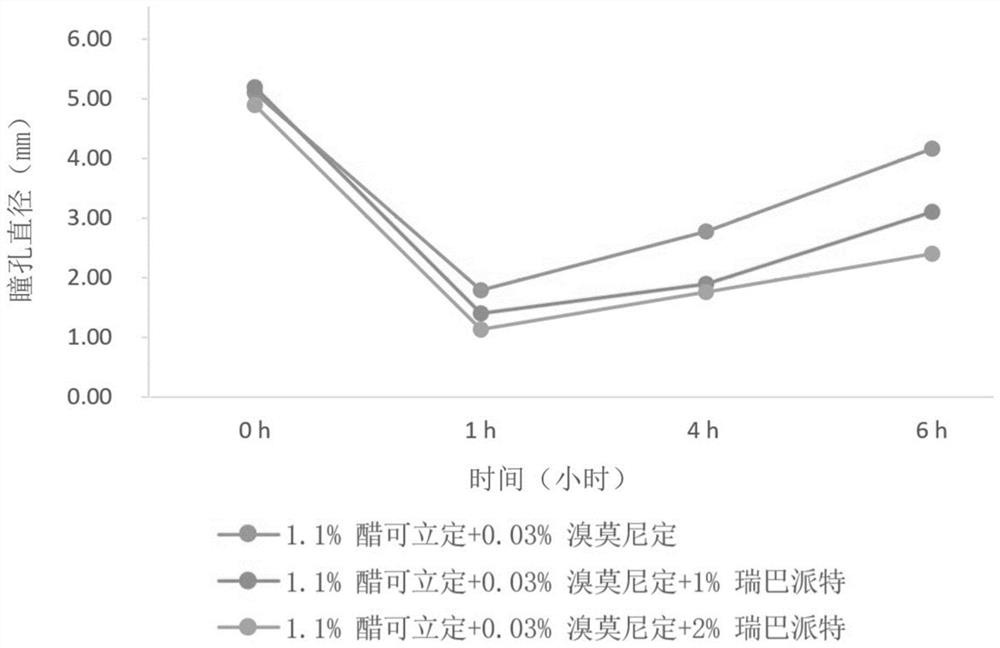Ophthalmic preparation and application thereof in treating presbyopia
An ophthalmic preparation and technology for presbyopia, which is applied in the field of rebamipide and acetone, can solve the problems of presbyopia that have not yet been established with acetone, and achieve the effects of strengthening, delaying long-term progress, and reducing related side effects
- Summary
- Abstract
- Description
- Claims
- Application Information
AI Technical Summary
Problems solved by technology
Method used
Image
Examples
Embodiment 1
[0091] Example 1 drug combination screening based on target information
[0092]Based on the analysis of the previous literature, it was found that the current presbyopia-related treatment drug mechanisms mainly include: 1) Muscarinic acetylcholine receptor M3 excitation; 2) COX-2 inhibitors; 3) Antioxidant drugs. Pharmacological network model is recommended for drug screening according to key nodes. At the same time, the COX-2 protein structure (PDB: 4PH9) and the muscarinic acetylcholine receptor (PDB:4DAJ) were selected as the key proteins, and the results were combined with the pharmacological network model after virtual screening using the ZINC drug structure database, and the score was based on the weights of the edges in the network. After screening, it was found that rebapirate ranked first among all drugs, and the top twenty molecules in the model included diclofenac (twelfth) and bromfenac (fourth), and so on.
Embodiment 2
[0093] Example 2 Method of preparing an ophthalmic formulation for the treatment of presbyopia
[0094] 1. Method for preparing compositions
[0095] (1) The excipients are dissolved
[0096] (1) Dissolution of carboxymethyl cellulose CMC (McLean: C889437): Take 1 2L beaker to take about 1500mL of ultrapure water at 80 °C, use an LED overhead stirrer to slowly add carboxymethyl cellulose CMC while stirring, stir for about 7h and continue to add other excipients.
[0097] (2) Add sodium chloride NaCl: observe the CMC solution, add sodium chloride after the CMC is completely dissolved, and continue to stir for 10 min.
[0098] (3) Add hydroxypropyl-β-cyclodextrin HPBCD (Bid: BD44359): Slowly add hydroxypropyl-β-cyclodextrin HPBCD and stir until dissolved, stirring for about 1h.
[0099] (4) Add benzalkonium chloride BAK: Benzalkonium chloride BAK is dissolved in about 50mL ultrapure water, and then added to the above CMC solution drop by drop, and continue to stir for 10min.
[0100...
Embodiment 3
[0116] Example 3 animal irritation test
[0117] 1. Experimental methods
[0118]Animal experiments with rabbits as research objects, randomly divided into control group and experimental group #1-#9, for each experimental group, the use of single dose administration, the corresponding number of drugs are given to drop the right eye, each administration is 50 μL, the control group does not administer, the left eye of the experimental group is administered with the same dose of normal saline; Slit lamps were used to check the pupil size at 0min, 10min, 20min, 30min, 1h, 2h, 4h, 6h after a single dose, and the degree of corneal opacity, conjunctival hyperemia, edema and secretion, iris congestion or bleeding were scored according to the Draize stimulation experiment scoring standard at 30min, and the irritation rating was performed. The overall results show that when the eye drops score of the animal eye irritation is less than 3, it can be considered that there is no obvious irritat...
PUM
 Login to View More
Login to View More Abstract
Description
Claims
Application Information
 Login to View More
Login to View More - R&D
- Intellectual Property
- Life Sciences
- Materials
- Tech Scout
- Unparalleled Data Quality
- Higher Quality Content
- 60% Fewer Hallucinations
Browse by: Latest US Patents, China's latest patents, Technical Efficacy Thesaurus, Application Domain, Technology Topic, Popular Technical Reports.
© 2025 PatSnap. All rights reserved.Legal|Privacy policy|Modern Slavery Act Transparency Statement|Sitemap|About US| Contact US: help@patsnap.com



